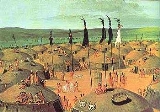
Fort Clark Trading Post State Historic Site
Encyclopedia
Fort Clark Trading Post State Historic Site was once the home to a Mandan and later an Arikara
settlement. Over the course of its history it also had two factories (trading posts)
. Today only archeological remains survive at the site located eight miles west of Washburn, North Dakota
.
. In 1830, a representative of the American Fur Company
built Fort Clark Trading Post south of the village. The first steamboat
to journey up the upper-Missouri River was the Yellow Stone which arrived in 1832 carrying 1,500 gallons of goods and liquor. George Catlin
, Karl Bodmer
, and the German
Prince Maximilian of Wied-Neuwied
all visited the site and stayed the winter of 1832-1833. In 1837, the steamboat St. Peters docked at the village carrying passengers infected with smallpox
. As the disease swept through the village, it wiped out approximately ninety-percent of the inhabitants. In 1838, the nearby Arikara
tribe moved into the abandoned village. In 1850, another trading post was built by Charles Primeau. In 1851, a cholera
outbreak occurred and then a smallpox outbreak in 1856. When an attack by the Dakota
happened in 1861, the fort was permanently abandoned.
. More than 2,200 features on the surface from the ruins of houses and graves still exist. Lodge depressions are also visible along with an unmarked cemetery with more than 800 graves. The site is operated by the North Dakota State Historical Society.
Arikara
Arikara are a group of Native Americans in North Dakota...
settlement. Over the course of its history it also had two factories (trading posts)
Factory (trading post)
Factory was the English term for the trading posts system originally established by Europeans in foreign territories, first within different states of medieval Europe, and later in their colonial possessions...
. Today only archeological remains survive at the site located eight miles west of Washburn, North Dakota
Washburn, North Dakota
Washburn is a city in McLean County, North Dakota in the United States. It is the county seat of McLean County. The population was 1,246 at the 2010 census...
.
History
In 1822, the Mandan tribe built a settlement with earth-covered lodges on the bluffs of the Missouri RiverMissouri River
The Missouri River flows through the central United States, and is a tributary of the Mississippi River. It is the longest river in North America and drains the third largest area, though only the thirteenth largest by discharge. The Missouri's watershed encompasses most of the American Great...
. In 1830, a representative of the American Fur Company
American Fur Company
The American Fur Company was founded by John Jacob Astor in 1808. The company grew to monopolize the fur trade in the United States by 1830, and became one of the largest businesses in the country. The company was one the first great trusts in American business...
built Fort Clark Trading Post south of the village. The first steamboat
Steamboat
A steamboat or steamship, sometimes called a steamer, is a ship in which the primary method of propulsion is steam power, typically driving propellers or paddlewheels...
to journey up the upper-Missouri River was the Yellow Stone which arrived in 1832 carrying 1,500 gallons of goods and liquor. George Catlin
George Catlin
George Catlin was an American painter, author and traveler who specialized in portraits of Native Americans in the Old West.-Early years:...
, Karl Bodmer
Karl Bodmer
Karl Bodmer was a Swiss painter of the American West. He accompanied German explorer Maximilian zu Wied-Neuwied from 1832 through 1834 on his Missouri River expedition...
, and the German
Germany
Germany , officially the Federal Republic of Germany , is a federal parliamentary republic in Europe. The country consists of 16 states while the capital and largest city is Berlin. Germany covers an area of 357,021 km2 and has a largely temperate seasonal climate...
Prince Maximilian of Wied-Neuwied
Prince Maximilian of Wied-Neuwied
Prince Alexander Philipp Maximilian zu Wied-Neuwied was a German explorer, ethnologist and naturalist....
all visited the site and stayed the winter of 1832-1833. In 1837, the steamboat St. Peters docked at the village carrying passengers infected with smallpox
Smallpox
Smallpox was an infectious disease unique to humans, caused by either of two virus variants, Variola major and Variola minor. The disease is also known by the Latin names Variola or Variola vera, which is a derivative of the Latin varius, meaning "spotted", or varus, meaning "pimple"...
. As the disease swept through the village, it wiped out approximately ninety-percent of the inhabitants. In 1838, the nearby Arikara
Arikara
Arikara are a group of Native Americans in North Dakota...
tribe moved into the abandoned village. In 1850, another trading post was built by Charles Primeau. In 1851, a cholera
Cholera
Cholera is an infection of the small intestine that is caused by the bacterium Vibrio cholerae. The main symptoms are profuse watery diarrhea and vomiting. Transmission occurs primarily by drinking or eating water or food that has been contaminated by the diarrhea of an infected person or the feces...
outbreak occurred and then a smallpox outbreak in 1856. When an attack by the Dakota
Sioux
The Sioux are Native American and First Nations people in North America. The term can refer to any ethnic group within the Great Sioux Nation or any of the nation's many language dialects...
happened in 1861, the fort was permanently abandoned.
Today
Fort Clark is listed on the National Register of Historic PlacesNational Register of Historic Places
The National Register of Historic Places is the United States government's official list of districts, sites, buildings, structures, and objects deemed worthy of preservation...
. More than 2,200 features on the surface from the ruins of houses and graves still exist. Lodge depressions are also visible along with an unmarked cemetery with more than 800 graves. The site is operated by the North Dakota State Historical Society.

